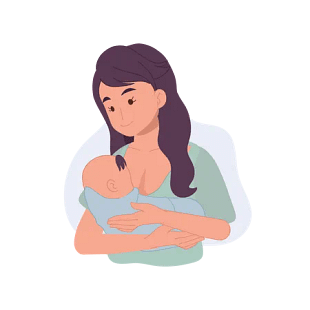
Most parents’ complaint is that my child is not eating anything. Feeding is often a battle between mother and child.
- This is an area that requires patience and perseverance.
- It is advisable not to eat a lot of food but to eat less food with high nutritional value
- Must know what foods to give and how to give them.
- Make sure the child’s weight is adequate
- Exercise should be developed as a habit
Breastfeeding the child

- UNICEF considered the first 1000 days of life, i.e. 270 days in the womb and the first two years after birth, as the critical period for nutritional interventions.
- Skin-to-skin contact (kangaroo care) for all normal newborns (including those delivered by caesarean section) should begin within approximately 5 minutes. The baby can start breastfeeding within an hour.
- When breastfeeding, when the baby feels sleepy, stop breastfeeding and put him in bed and put him to sleep by gently patting his back. Breastfeeding causes tooth decay in the future.
- Breastfeed when baby shows signs of hunger. Early hunger cues include sucking movements, vocalizations, mouth movements, rapid eye movements, soft moaning or breathing sounds, lip smacking, restlessness, etc. Crying is a late sign. Urinating 8 times in 24 hours and gaining enough weight will ensure that you are getting enough breast milk. Babies should breastfeed at least 8 to 10 times in 24 hours.
- Remove blankets, remove clothing, change hands when wet, lie in skin-to-skin contact in the kangaroo position and gently massage the back and limbs to wake up.
- Exclusively breastfeed up to 6 months.
- One or two nutritious snacks between three main meals can ensure adequate total energy intake. Do not give more snacks instead of main meals. Food items such as sweets, chips or other processed foods should not be considered snacks.
- Parents should ensure adequate nutritional values of home-cooked staple food (fresh, clean and affordable).
- There should be a separate area for breastfeeding in public places (bus stands, railway stations, airports).
Complementary food

- Appropriate solid chewable foods from locally available foods can be introduced along with breastfeeding at six months of age.
- When to start meat diet?
- Give only vegetarian food at 6 months, start meat food from 7 to 8 months.
- Start with eggs, then fish and red meat.
- Start by giving meat only twice a week, then only once a day.
- Avoid all processed meats completely.
- Goat’s milk and cow’s milk should not be given until 10 months or 1 year.
- Each meal should be made energy dense by adding sugar/jaggery and ghee/butter/oil as more food cannot be digested. Foods that provide more calories from smaller amounts should be denser.
- Parsley, sprouted grains and roasting the grains before grinding can increase the nutritional value of the food.
- Do not use bottles for any reason.
- Hygienic practices at all stages of food preparation, storage and consumption are essential for food safety. Practice hand washing with soap and water whenever necessary, including before eating, preparing food, and using the toilet.
- Practice responsible eating habits.
- Encourage self-feeding. Each child should be fed under your supervision on a separate plate for individual development. Forced feeding, threats and punishment can hinder the development of good/proper eating habits.
- A particular meal at least 10 times in different situations The consistency, chewing and swallowing of foods should be appropriate for the child’s developmental readiness. Do not feed foods that are likely to go to the lungs. All tastes should be introduced by about 9 to 10 months.
- Composition of food according to age
- Start with
- 6-8 mo thick porridge, finely ground foods
- 9-11 mo Finely chopped or powdered foods and foods that the baby can take
- 12-23 mo Whole family foods, chopped or powdered foods if needed
- How often
- Feed 2-3 times a day, and breastfeed frequently
- 3-4 times a meal and breast milk. 1-2 snacks according to appetite
- 3-4 times feeding and breastfeeding. 1-2 snacks according to appetite
- Start with an average of 2-3 tablespoons per meal
- Start with 1/2 cup of 10.250ml and work up to 3/4 to 1 cup.
- Start with
- Feeding during illness is important for recovery and prevention of malnutrition. Even sick babies continue to breastfeed, encouraging the child to eat small nutritious meals more often and feeding the child the foods he or she likes to eat.
- Food items rich in micronutrients GYOR (green, yellow, orange, red) vegetables and fruits should be encouraged
Junk food and baby food

(a) Often consumers are fooled by nutritional and health claims, while children are influenced by advertisements that tempt them to buy an unhealthy or actually harmful product.
(b) Although companies promote many foods as “magic foods”, parents should understand that such products do not exist.
(c) Avoid junk and commercial food (sugar, salt, fat, additives/preservatives, pesticides) high in SSFAP.
(d) Junk foods are a major cause of increasing childhood obesity. Junk food consumption needs to be curbed in educational institutions and remote areas of the country.
For school age :
A child should eat four full meals a day. Include fruits, probiotic yogurt, vegetable juices, fish, and meat.
The nutrients your kids need

Cereals: Cereals are an important part of a healthy diet that provides the nutrients and energy needed for a child’s natural growth and development. A variety of grains should include high-fiber varieties such as breads, cereals, rice, and oats. High amounts of sugar, fat (especially saturated fat), and salt should be avoided as much as possible.
Fruits and vegetables: contain a lot of water, vitamins, minerals and fiber, and contain a lot of calories. A child should eat 5 portions of fruits and vegetables a day.
Fats and oils: An important part of your child’s or teen’s diet, they play an important role in your child’s brain development, helping them reach their maximum growth potential. Fat is used as fuel in our body. Fat-soluble vitamins A, D, E and K help the body absorb them. Fatty foods are often linked to overweight, obesity, heart disease, and stroke. But eating the right fats can provide health benefits to the body.
Milk and milk products: These are excellent sources of vitamins A, D, B1, B2, B12 and minerals. This is especially important for children and adolescents. .
Meat and Legumes: Meat, poultry, fish, lentils, eggs, nuts and seeds provide many nutrients. It is an important part of a healthy diet. These foods are rich in protein. Proteins are required for various functions in your body, therefore, it is important to include them in your diet. Meat is also a good source of vitamin B12 and iron. Iron-rich foods can help prevent iron deficiency anemia. This is a common condition seen in children and can cause low energy and anemia. Instead of meat, soy, beans, eggs, milk, cheese, yogurt, mushrooms, and nuts can be given.
General recommendations
- As much as possible, all children and adolescents should avoid junk foods and beverages.
- Limit consumption of junk foods and suggest eating no more than once per week;
- Do not buy such food as a reward.
- Do not eat while watching television.
- Traditional and acceptable homemade snacks can be offered to children as substitutes for junk meals. Lunch boxes containing only healthy food should be taken to school.
- Encourage them to eat fruits instead of fruit juices.
- Children below 2 years of age and small children should not be given fruit juices/fruit juices/colas etc.
- Fruit juices, fruit drinks and SSBs should be avoided as much as possible in children and adolescents (2-18 years).
- Water should be promoted as the best drink.
- If juice is given, only 125 ml per day for children aged 2-5 years and 250 ml per day for children above 5 years of age.
Caffeinated beverages
- Caffeinated energy drinks should not be consumed by children and teenagers.
- Carbonated drinks, tea and coffee should be avoided in children <5 years of age.
- In school-aged children and adolescents, tea/coffee consumption should be limited to a maximum of half a cup/day (100 ml) in 5–9 y and to one cup/day (200 ml) in adolescents (10–18 y).
Physical activity

- Daily tasks: walking, climbing stairs, cycling, household chores etc.
- Exercise: Planned and structured activities of leisure-time physical activity performed to improve or maintain physical fitness.
- Sports: This includes competitions. It can become a profession
There are 3 levels of exercises.
- Exercises for the heart and lungs.
- To increase muscle strength
- For stamina and flexibility
Excessive TV watching along with junk food and aerated drinks leads to weight gain.
Four days a week, 30-60 minutes of moderate physical activity is required
No need to exercise continuously
10-15 minute activities several times a day divisible










































